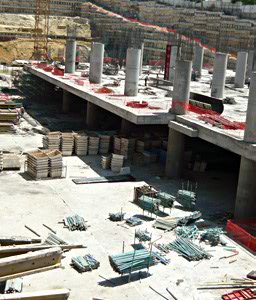|
 |
Diaphragm Walls
Diaphragm walls are underground structural elements commonly used for retention systems and permanent foundation walls. They are also used as deep groundwater barriers.
Diaphragm walls are constructed using the slurry trench technique, which was developed in Europe and has been used in the Turkey since the 1980s. The technique involves excavating a narrow trench that is kept full of an engineered fluid or slurry. The slurry exerts hydraulic pressure against the trench walls and acts as shoring to prevent collapse. Slurry trench excavations can be constructed in all types of soil, even below the groundwater table.
Cast in place diaphragm walls are usually excavated under bentonite slurry. Various types of excavation equipment can be used depending on project conditions, including hydraulic excavators, and kelly-mounted or cable-hung clam buckets.
Diaphragm wall construction begins with the trench being excavated in discontinuous sections or “panels”. Stop end pipes are placed vertically at each end of the primary panel to form joints for adjacent secondary panels. Panels are usually 3 to 6 meter long with widths varying from 0.6 to 1.8 meter.
Once the excavation of a panel is complete, a steel reinforcement cage is placed in the center of the panel. Concrete is poured in one continuous operation through one or more tremie pipes that extend to the bottom of the trench. The tremie pipes are extracted as the concrete rises; however, the discharge end of the tremie pipe always remains embedded in the fresh concrete.
The slurry that is displaced by the concrete is saved and reused for subsequent panel excavations. When the concrete sets, the end pipes are withdrawn. Similarly, secondary panels are constructed between the primary panels to create a continuous wall. The finished wall may be cantilever or require anchors/props for lateral support.
A variation of the technique is the precast diaphragm wall. With this method a continuous trench, or longer panel, is excavated under self-hardening cement bentonite slurry. The slurry is retarded to remain fluid during construction. After a sufficient length of excavation is complete, a crane lifts the precast concrete wall section into the trench. The cement bentonite slurry sets to form the final composite wall. Alternately, the trench is excavated under bentonite slurry, which is then displaced with cement bentonite slurry.
Diaphragm walls are commonly used in congested areas. They can be installed in close proximity to existing structures with minimal loss of support to existing foundations. In addition, construction dewatering is not required, so there is no associated subsidence.
The cut and cover method is used to construct tunnels. Two parallel diaphragm walls are installed and the area between the walls is excavated. Floor and roof slabs are poured and the area above the roof is backfilled.
Back to page |